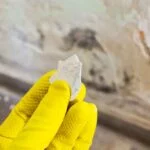The wood destroying fungus Serpula Lacrymans, commonly known as dry rot, is seen all over the world. It can be devastating; destroying timber wherever conditions are perfect for it to thrive. Although it is seen in nature destroying trees in forests and woods, where it is a particular concern is in your home. This article will explain what dry rot is, how to identify it, and how to eradicate it.
So what is dry rot?
Dry rot is a fungus, its spores are everywhere, invisible to the naked eye. These spores are generally harmless, and are only able to thrive in wood with a moisture content over 20%. However, when these spores come into contact with timber in the right conditions, they begin to germinate rapidly.
This fungal growth eats away at the nutrients in the wood, making the timber become darker and more brittle. Timber infected with dry rot is dangerous, particularly if it is load bearing, and can lead to permanent damage within a property, even resulting in structures collapsing. What is more it can spread like wildfire, it has been known to grow at as much as 1 metre in as little as a month!
Dry rot does not feed on masonry and other services, however it can spread through brickwork and masonry to reach more timber to feed off, meaning that it is extra important to catch and treat dry rot quickly.
How to identify dry rot
At first, dry rot appears as a white, almost cotton-wool like sheet called mycelium on timber and brickwork. This is followed by a fruiting body called a sporophore. These fruiting bodies are often a rusty red colour in the centre with a white colour around the outside. It is sometimes the rest dust (spores) from these fruiting bodies that can be the first noticeable sign of a dry rot problem.
Looking at the qualities of the wood itself is often another way that dry rot can be identified. The wood will have dried out, be dark in colour and have shrunk considerably. The wood will be brittle, cracked and be easily broken.
A common indicator of a dry rot problem can also be the smell. Dry rot emits a musty, damp fungal smell, which is also usually associated with damp.
Dry rot treatment
The first step is to call a professional such as Keith Rennie to survey your property, and diagnose that it is indeed dry rot that is the problem. Once this is done, and dry rot has been confirmed, the next step will be twofold: identify any sources of moisture entering the affected area (such as leaky gutters or roof failure), and to remove the infected timbers. Often surrounding plaster will also need to be removed in the process, to ensure adequate treatment.
Once this is done, the surrounding area may need to be chemically treated with fungicides in order to prevent reinfection when new timber is installed. New timbers will then be installed and pre-treated to ensure dry rot does not return.
Preventing further attacks
A lot of the work undertaken when treating dry rot is also an attempt to ensure it does not return. One of the key aspects of this is making sure that the area is well ventilated, and that issues such as condensation are kept under control, as well as the relevant fungicide treatments.
Think you might have a dry rot problem? Contact Keith Rennie today!








